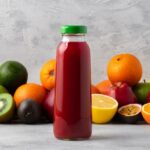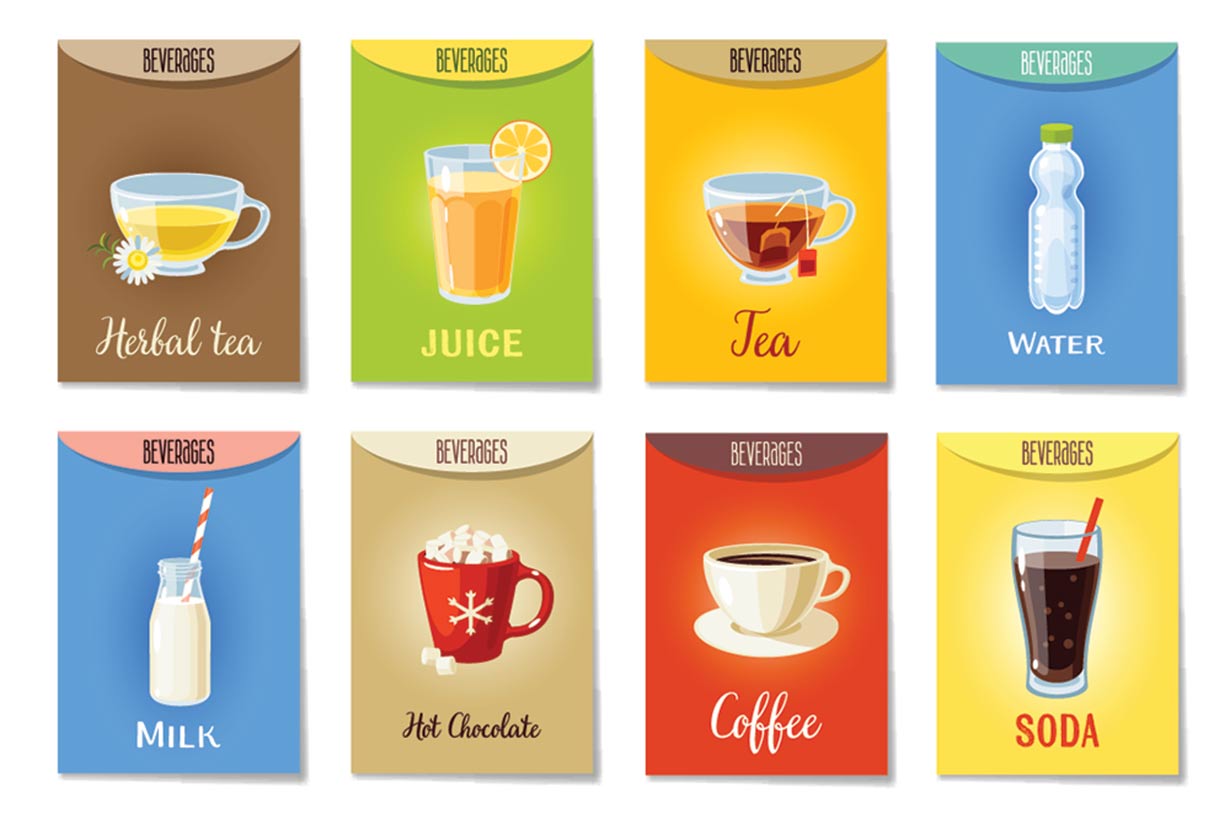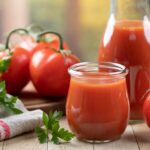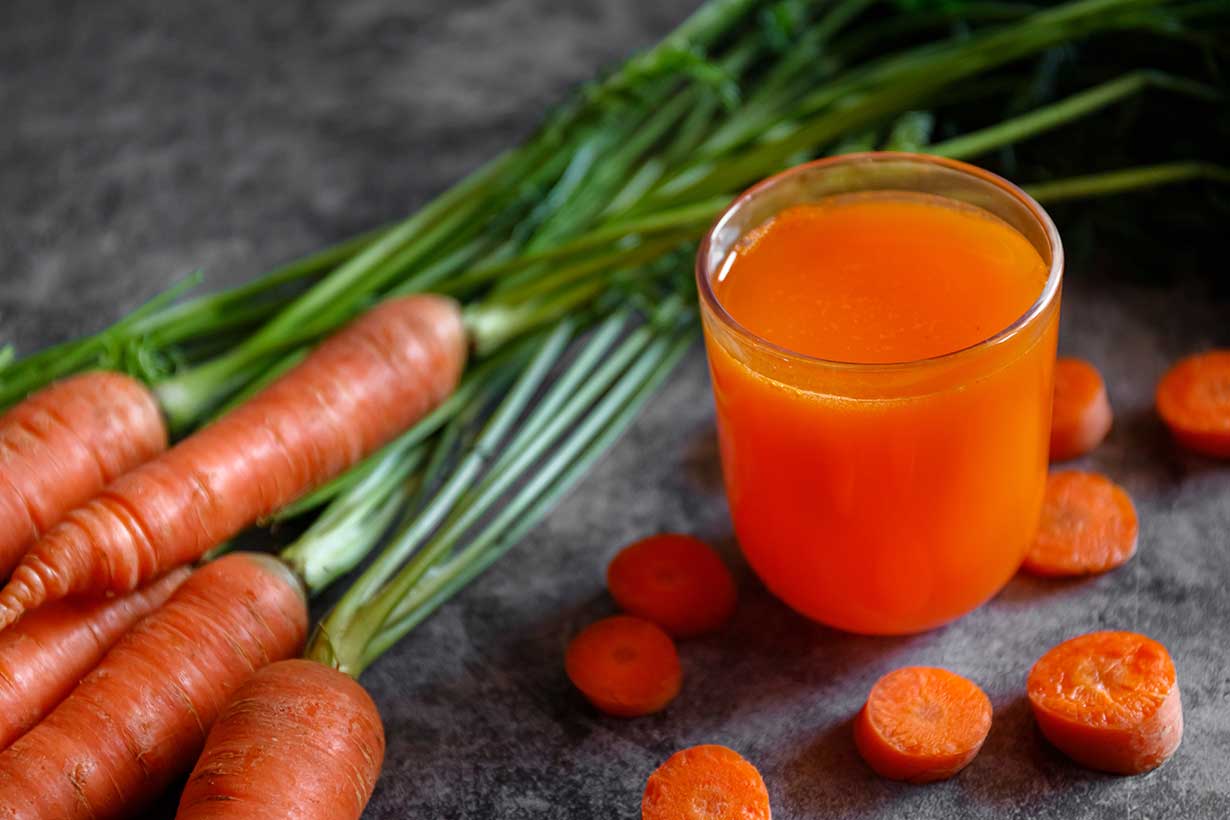Blended vegetable juice options have become more popular in recent decades, supported by the growing appearance of juice bars.
As a drink, these juices contain fewer sugars and calories compared to fruit juice, yet often provide higher amounts of essential vitamins and minerals.
This article provides a nutritional overview of five of the most popular types of vegetable juice. Additionally, what benefits and drawbacks might vegetable juice have over whole vegetables?
Table of contents
Nutrition Facts For Popular Types of Vegetable Juice
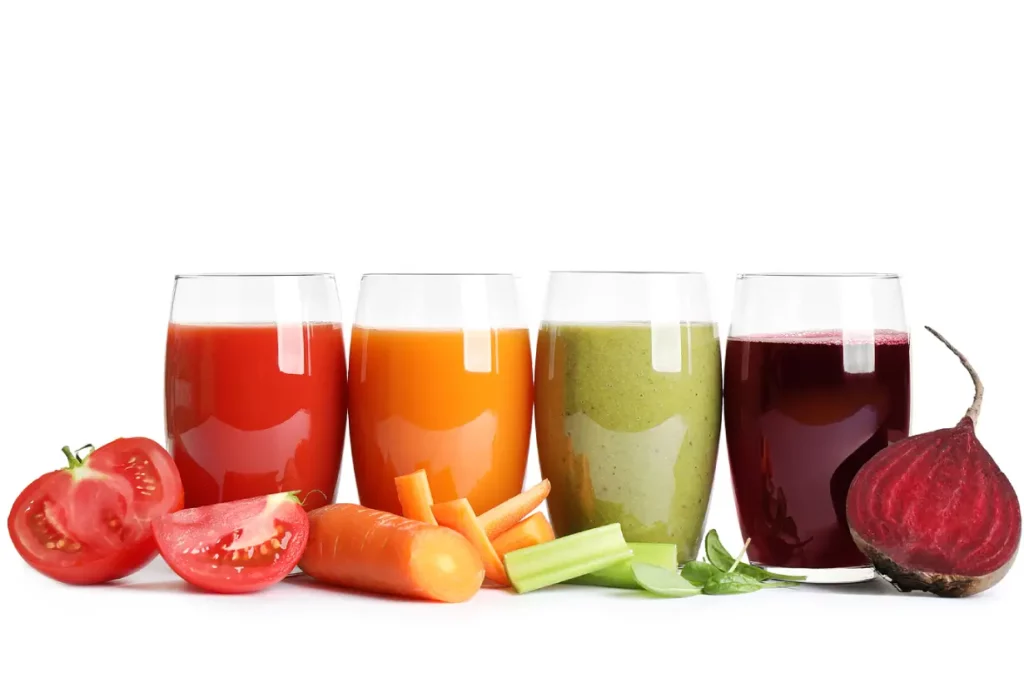
The following table provides an at-a-glance comparison of the nutritional values for five of the most popular vegetable juice varieties.
These options include beet, carrot, celery, spinach, and tomato juice. With the exception of spinach juice, nutritional data has been sourced from the USDA’s FoodData Central database (1, 2, 3, 4).
The data on spinach juice comes from the University of Minnesota’s NCC Food and Nutrient Database, accessed through Cronometer (5).
| Nutrient | Beet | Carrot | Celery | Spinach | Tomato |
|---|---|---|---|---|---|
| Calories | 62 kcal | 96 kcal | 40 kcal | 8 kcal | 57 kcal |
| Carbohydrates | 14.7 g | 22.3 g | 7.84 g | 1.38 g | 10.7 g |
| Fiber | 2.73 g | 1.92 g | 3.78 g | 0.88 g | 0.99 g |
| Sugars | 12.0 g | 9.38 g | 3.16 g | 0.16 g | 6.37 g |
| Fat | 0.15 g | 0.36 g | 0.38 g | 0.09 g | 0.72 g |
| Protein | 1.79 g | 2.28 g | 1.16 g | 1.09 g | 2.13 g |
| Key nutrient | Nitrate | Vitamin A | Potassium | Vitamin K | Lycopene |
Beet Juice
Key nutrient: Nitrate
Beet juice is among the best dietary sources of nitrate, a naturally occurring compound composed of nitrogen and oxygen (6).
Research on beet juice available at retail indicates that a 248-gram cup serving may contain between 198 mg and 298 mg of nitrate (7). However, nitrate-enriched supplementary beet juice products may provide up to 462 mg of nitrate per cup (8).
Large systematic reviews demonstrate that nitrate supplementation can lower blood pressure, potentially in a dose-response manner (9, 10).
Beet juice is sometimes used as a supplement before exercise, as evidence supports nitrates as having potential performance-enhancing effects. This is because nitrates convert to nitric oxide in the body, which enhances blood flow and oxygen delivery (11).
A systematic review on the topic found evidence for beet juice improving cardiorespiratory endurance (11).
Carrot Juice
Key nutrient: Vitamin A
Carrot juice stands out for its incredible vitamin A content, which comes in the form of beta-carotene.
When we consume beta-carotene, it requires conversion into the active form of vitamin A—known as retinol—and this conversion rate can be inefficient (12).
However, since carrot juice contains significant amounts of beta-carotene, it still converts to substantial amounts of vitamin A.
A 240-gram cup of carrot juice provides about 22,300 mcg of beta-carotene, which is the retinol activity equivalents (RAE) of 2,290 mcg of vitamin A—254% of the daily value (2).
Celery Juice
Key nutrient: Potassium
Celery juice may not be as well-known as other juice varieties, but it’s a highly nutritious option.
For instance, its key nutrient is potassium, which, according to the U.S. Dietary Guidelines for Americans, is a nutrient that many don’t consume in sufficient quantities. Diets higher in potassium can help to lower blood pressure (13, 14).
A 236-gram cup of celery juice offers 625 mg of potassium, which is 13% of the recommended daily value (3).
Celery juice also offers an excellent amount of fiber for relatively small amounts of calories and total carbohydrates.
Spinach Juice
Key nutrient: Vitamin K
Since spinach is mostly water—93% according to the USDA—it has very few calories (15).
If most of the caloric solids are removed when making spinach juice, this leaves very few calories in the drink. In fact, NCC data shows that a 236-gram cup of spinach juice contains only 8 calories.
Furthermore, the caloric content of spinach juice may be further diluted if added water is used in the production process.
Despite its extremely low calorie content, spinach juice is still extremely rich in micronutrients. A single cup provides 181 mcg of vitamin K, which is roughly 150% of the daily value.
Vitamin K is an essential vitamin that is crucial for strong bones and the body’s blood-clotting processes, which are important for healing tissue damage (16).
Spinach juice is also a good source of folate and vitamin A.
Tomato Juice
Key nutrient: Lycopene
Tomato juice is a powerhouse when it comes to lycopene, an interesting non-vitamin A carotenoid linked to various health benefits.
In this regard, a cup of tomato juice provides 22,400 mcg of lycopene per cup (4), approximately sevenfold the amount of lycopene in a medium tomato (17).
An umbrella review of systematic reviews and meta-analyses published in 2021 found that lycopene intake was associated with lower all-cause mortality and cardiovascular disease (18).
As well as being high in lycopene, tomato juice is an excellent source of potassium, providing more than 10% of the daily value per cup (4).
Does Vegetable Juice Have Any Benefits Over Fresh Vegetables?
A clear benefit of vegetable juices is that they’re convenient and don’t require any preparation, but do they have any other benefits compared to fresh vegetables?
The answer here is yes—they can have some advantages, but it depends on context.
Let’s take a look:
- Quick and convenient: While some vegetables can be eaten raw, most people prefer to cook them. However, drinking vegetable juice simply involves either buying a ready-made product or blending the vegetable at home. At this point, all one has to do is drink the juice, with no lengthy cooking processes or sit-down meals necessary.
- Easier to consume larger amounts of vegetables: For those who don’t particularly like vegetables, drinking them as a juice makes it easier and quicker to eat a higher volume of vegetables than eating whole, fresh vegetables.
- Easier to digest: Whole vegetables contain fibrous cell walls, which can be difficult to chew and digest—especially for older adults with dental or digestive issues. Juicing vegetables either removes or breaks down these fibrous tissues, making the juice simpler to digest with no chewing necessary.
Key point: Vegetable juice can make vegetables quicker, more convenient, and easier to digest than consuming whole, fresh vegetables.
Does Vegetable Juice Have Any Downsides?
As we’ve seen, vegetable juice can have some benefits over fresh vegetables. However, it can also have potential drawbacks, and we’ll take a quick look at these now.
Here are some drawbacks for consideration:
- May have less fiber: Depending on how the juice is made, it may have a lower fiber content than an equivalent amount of fresh vegetables. This is because some juices discard the pulp from the produce to ensure a smooth and consistent liquid drink.
- May contain less vitamin C: Vitamin C is prone to oxidation from light, heat, and oxygen (19). This means that vegetables processed into juice and stored for extended periods are likely to have significantly reduced vitamin C levels (20). This is less of an issue if the juice is consumed after being freshly made, in which case vitamin C losses are likely to be minimal.
- Homemade vegetable juices are perishable: According to the USDA’s FoodKeeper Food app—developed by the Food Safety and Inspection Service—homemade vegetable juice should be stored for a maximum of 3–5 days (21). While exact times can vary, fresh vegetables can typically last for around a week or more in the refrigerator. Note: This may not apply to store-bought vegetable juices—many commercial juices are pasteurized for a longer shelf life.
- May be less satiating than whole, fresh vegetables: Satiating refers to feeling full after consuming food, with a lack of desire to eat further. While there is little direct evidence comparing fresh vegetable and vegetable juice, it is likely that vegetable juice won’t be as satiating as fresh vegetables. For instance, one study demonstrated that whole fruit increased satiety more than fruit juice (22). A systematic review on how food texture influences satiety also found that solid and thicker foods enhance satiety more than liquids (23).
Key point: Some downsides of vegetable juice include its potential for increased perishability, lower vitamin C content, and a relative lack of fiber and satiation.
Summary
Some of the most popular types of vegetable juice include beet, carrot, celery, spinach, and tomato juice. These juices supply large amounts of important nutrients and beneficial compounds, including lycopene, nitrate, potassium, and vitamins C and K.
Including vegetable juice in the diet can offer several benefits, making it easier to consume larger amounts of vegetables and the nutrients they contain.
However, it may not always have the same content of fiber and vitamin C as fresh vegetables. Additionally, whole vegetables likely have a greater influence on satiety—the feeling of being full after a meal.

